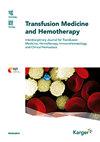急性淋巴细胞白血病患者四次CAR-T细胞桥接两次同种异体造血干细胞移植治疗
IF 1.9
4区 医学
Q3 HEMATOLOGY
引用次数: 0
摘要
& lt; b> & lt; i>简介:& lt; / i> & lt; / b>嵌合抗原受体T (CAR-T)细胞疗法是治疗复发或难治性急性淋巴细胞白血病(ALL)的同种异体造血干细胞移植(alloo - hsct)的有效桥接疗法。然而,由于技术上的困难以及患者的身体、经济和社会条件,重复CAR-T细胞治疗和同种异体造血干细胞移植只能在少数患者中进行。& lt; b> & lt; i>案例表示:& lt; / i> & lt; / b>一位23岁的女性b细胞ALL (B-ALL)二次复发患者接受了2次人鼠嵌合CD19 CAR-T细胞治疗,1次人鼠嵌合CD22 CAR-T细胞治疗,1次人源化CD19 CAR-T细胞治疗。此外,她先后接受了一次母亲的同种异体造血干细胞移植和一次表亲的同种异体造血干细胞移植。& lt; b> & lt; i>结论:& lt; / i> & lt; / b>对于复发或难治性ALL患者,重复CAR-T细胞治疗与重复同种异体造血干细胞移植的桥接仍然是一种安全而积极的治疗策略。本文章由计算机程序翻译,如有差异,请以英文原文为准。
Quartic CAR-T Cell Bridging to Twice Allo-HSCT Therapy in a Patient with Acute Lymphoblastic Leukemia
Introduction: Chimeric antigen receptor T (CAR-T) cell therapy is an effective bridging treatment for allogeneic hematopoietic stem cell transplantation (allo-HSCT) in relapsed or refractory acute lymphoblastic leukemia (ALL). However, repetitive CAR-T cell therapy and allo-HSCT can only be performed in a few patients because of technical difficulties and patients’ physical, economic, and social conditions. Case Presentation: A 23-year-old female patient with second relapsed B-cell ALL (B-ALL) underwent human-murine chimeric CD19 CAR-T cell therapy twice, human-murine chimeric CD22 CAR-T cell therapy once, and humanized CD19 CAR-T cell therapy once. Moreover, she was sequentially bridged to her mother donor allo-HSCT once and cousin donor allo-HSCT once. Conclusion: Repetitive CAR-T cell therapy bridging to repetitive allo-HSCT is still a safe and active therapeutic strategy for patients with relapsed or refractory ALL.
求助全文
通过发布文献求助,成功后即可免费获取论文全文。
去求助
来源期刊
CiteScore
4.00
自引率
9.10%
发文量
47
审稿时长
6-12 weeks
期刊介绍:
This journal is devoted to all areas of transfusion medicine. These include the quality and security of blood products, therapy with blood components and plasma derivatives, transfusion-related questions in transplantation, stem cell manipulation, therapeutic and diagnostic problems of homeostasis, immuno-hematological investigations, and legal aspects of the production of blood products as well as hemotherapy. Both comprehensive reviews and primary publications that detail the newest work in transfusion medicine and hemotherapy promote the international exchange of knowledge within these disciplines. Consistent with this goal, continuing clinical education is also specifically addressed.

 求助内容:
求助内容: 应助结果提醒方式:
应助结果提醒方式:


